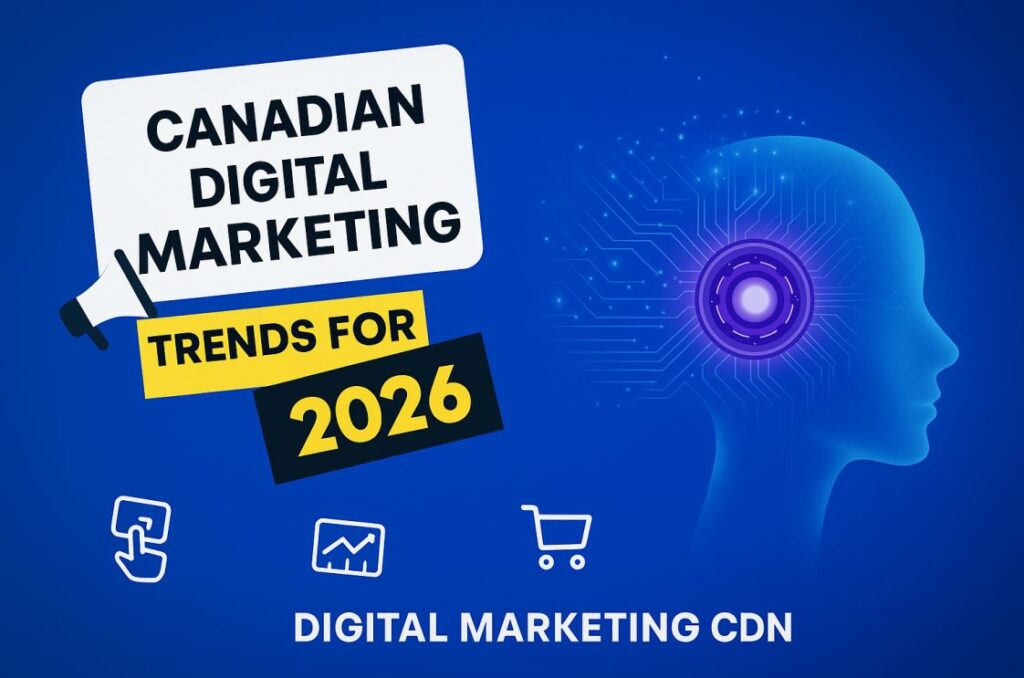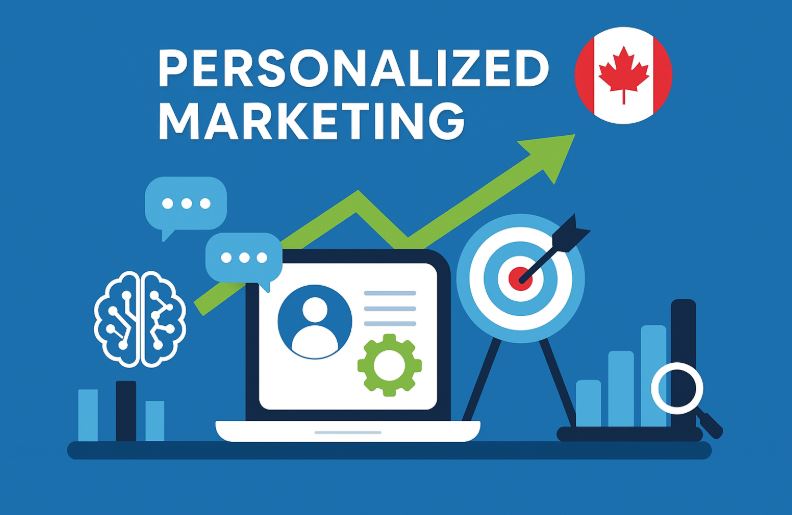MON - FRI: 8AM - 9PM
TEL: +250 815-5442
TEL: +250 815-5442

Change is the only constant in marketing — and in 2026, it feels faster, smarter, and surprisingly more human.
Across Canada, marketers are at an exciting crossroads: AI is helping spark creativity, but audiences are craving authenticity, privacy, and content that actually feels relevant to their lives.
So what happens when algorithms meet real human stories in one of the most digitally connected countries on earth?
Discover the top Canadian digital marketing trends in 2026 — from Search Engine Optimization (SEO) and email marketing to social media, AI personalization, and beyond — and see how local businesses are adapting and thriving.
Let’s explore.
Remember when ChatGPT and Midjourney first arrived, and every agency thought AI would replace copywriters and designers overnight? Fast-forward to now — that prediction didn’t age well.
Across Canada, AI in marketing has found its place as a co-pilot, not a competitor. Marketers have learned to use AI tools for idea generation, rapid testing, and content variation — but not for replacing human judgment. Brands that treat AI as a brainstorming partner, not a content mill, are the ones winning creative awards and engagement.
Take a Vancouver-based e-commerce brand selling outdoor gear. They use AI to generate 10 ad headlines per campaign, but final selection and storytelling are always human. The result? More creative range, less burnout, and a distinct brand voice that feels real — not robotic.
Success in AI-powered Canadian marketing isn’t about prompts — it’s about filters. The best marketers know when to reject AI outputs and inject empathy back in.
In recent years, conversations about data privacy have moved from niche concern to mainstream marketing reality. If 2025 was the year everyone panicked about cookies disappearing, 2026 is when Canadians finally got smart about first-party data and privacy-first marketing.
As Google’s privacy updates take full effect, brands relying solely on pixel tracking are struggling. Meanwhile, those who built genuine relationships — collecting emails, preferences, and opt-ins through value exchanges — are thriving.
One Montreal travel company redesigned its email signups: instead of “Join our newsletter,” they now say, “Get insider flight deals for your province.” That simple localization boosted their first-party data collection rate by 64%.
The lesson? Personalization starts with permission. Marketers are realizing that data transparency and CPPA compliance aren’t burdens — they’re competitive advantages. Canadians value honesty, and they reward brands that respect it.
Remember when only big brands could afford TV spots? Those days are gone.
In 2026, CTV streaming ads for Canadian small businesses have gone mainstream. Thanks to better targeting and lower costs, even small brands are running video ads on platforms like Roku, YouTube TV, and Crave.
CTV ads now combine the emotional power of TV with the precision of digital — and that’s changing how Canadians perceive brands. Instead of random interruptions, we’re seeing story-driven ads: authentic mini-documentaries, local founder stories, and behind-the-scenes clips.
A Calgary craft brewery recently ran a short ad series highlighting its partnership with local farmers — streamed directly to Albertan viewers. The campaign wasn’t just ads — it felt like a community story. And it worked: sales jumped 18% in a month.
If your brand has a story, CTV streaming ads for small businesses in Canada are the perfect place to tell it.
Here’s the irony of today’s marketing: the more we automate, the more consumers crave human connection.
Canadian audiences have developed a keen radar for fake enthusiasm, overly polished content, and AI-written fluff. The top-performing campaigns this year are emotional, honest, and specific to Canadian life.
A Halifax marketing agency recently ran a campaign for a local bookstore that celebrated “rainy-day readers.” Instead of fancy visuals, they filmed real customers curled up with tea during a Nova Scotia storm. It resonated deeply — not because it was perfect, but because it was real.
Now, imperfection is authenticity. Your next viral moment might not come from a perfect headline — it might come from authentic brand storytelling in Canada that shows your human side.

TikTok and Reels still dominate, but the format has matured. Gone are the random dances and lip-syncs — this is the era of short-form video micro-stories.
Canadian creators are leading the shift with short, narrative-driven clips that teach, entertain, or inspire in under 30 seconds. A Winnipeg-based real estate agent, for example, built a strong following by posting 20-second “Before & After” renovation tours — each ending with a simple line: “Would you live here?” The engagement? Massive.
Marketers are realizing they don’t need huge budgets to stand out. What matters now is consistency, authenticity, and a strong hook. The most successful brands post daily — not polished ads, but real moments that make audiences stop scrolling.
AI made it easy to flood the internet with content — and for a while, quantity seemed like the winning game. But both Google and local audiences have made one thing clear: quality and intent win every time.
The smartest SEO agencies in Canada aren’t chasing keywords anymore. They’re studying what people actually mean when they search — the questions behind the queries, not just the phrases themselves.
When someone searches “best winter tires Calgary,” they’re not looking for 2,000 words of fluff; they want trusted comparisons, real availability, and local expertise.
A single, in-depth, human-written guide — backed by Canadian data and expert storytelling — can outperform fifty generic posts. Google’s AI-driven Search Experience (SGE) now rewards content that answers the user’s need quickly, clearly, and credibly.
Search intent is the new SEO currency. Answer before you advertise, and value before volume.

Canadian marketers used to struggle with personalization — they wanted to tailor experiences without crossing privacy lines.
Now, AI-powered personalization in Canada has finally achieved that balance. Imagine landing on a retail site in Ontario and instantly seeing product recommendations tied to your local weather and seasonal needs — that’s personalization done right.
Retailers now combine first-party data and privacy-first marketing with AI to deliver contextual, not creepy, experiences. They use anonymized insights to predict needs — not to stalk customers. Major brands like Indigo and Sport Chek have already introduced region-specific personalization systems that learn preferences through interactions rather than invasive tracking.
Golden rule: Canadians love convenience, but they hate feeling watched. When your personalization feels like a helpful concierge — not a spy — you’ll win both hearts and conversions.
Canadians care deeply about sustainability — and that concern isn’t niche anymore. It’s mainstream.
From packaging to hosting, brands are being asked tougher questions about their environmental impact. Consumers aren’t impressed by “eco-friendly” claims anymore — they want receipts.
Marketers are adapting by telling the full story: where materials come from, how shipping is optimized, and even how carbon offsets are verified.
A Toronto fashion startup recently launched a “Made in Canada” series highlighting each step of its supply chain — not with corporate jargon, but real people and faces. The honesty boosted trust and sales alike, showing the power of sustainability-focused marketing in Canada.
The biggest marketing breakthroughs this year come from creative ideas informed by data — not dictated by it. Agencies are pairing data analysts with copywriters and designers in “creative pods.”
The result? Ads that not only look good but convert like crazy because they’re grounded in audience insights.
A Toronto fintech startup used analytics to discover that most sign-ups happened after seeing two testimonials and a comparison chart. They redesigned their landing page around that pattern and doubled their conversion rate within a month.
Data tells you what works. Creativity tells you why — the foundation of data-driven digital marketing in Canada.
Global brands are customizing campaigns for Canadian culture — and it’s paying off. Netflix, Spotify, and even major SaaS platforms are localizing their content using local slang, referencing regional events, and celebrating homegrown creators.
Even small businesses can adopt this mindset. Use local photos, mention city names, and reflect the rhythm of Canadian life — hockey nights, Tim Hortons runs, long winters, short summers.
That local flavor makes your brand feel Canadian-made — not copy-pasted.
Impressions and likes are old news. Marketers today are laser-focused on incrementality and lifetime value — not surface-level metrics.
Agencies now use experimental designs and lift studies to prove which channels actually drive revenue. A Vancouver SaaS company recently cut 40% of their ad spend — and grew faster. How? They stopped chasing vanity metrics and invested only in channels with measurable incremental value — a core principle of ROI-driven marketing in Canada.
The new mantra: “If you can’t prove it, pause it.”
The line between “brand marketing” and “performance marketing” has blurred. Performance teams are learning the value of storytelling, while brand teams are learning to measure their magic.
A national real estate company now measures not just leads but brand lift per dollar. Their CFO sees the numbers, their CMO sees the story — and finally, they’re speaking the same language.
This merger marks a maturity moment for Canadian brand-performance marketing — data and emotion are finally working together.

Scrolling is the new shopping, and Canadians are leaning in. What used to be a “like and move on” moment has become a full buying journey — right inside the feed. From TikTok Shop to Instagram Live, social commerce has gone mainstream in Canada, especially for local and lifestyle brands.
Social-driven sales are growing fast — Canadian social commerce is projected to surpass $2 billion by 2026, according to market analysts. That growth is being fueled by authenticity and interaction, not traditional ads.
Picture a Calgary boutique streaming a Saturday morning “shop-with-us” session or a Toronto chef hosting live demos where viewers can buy ingredients on the spot. These aren’t ads — they’re experiences. Viewers feel part of something real, not pushed through a funnel.
If your product solves a problem, tell its story in real time — that’s where today’s impulse turns into tomorrow’s loyalty.

Search has stopped being typed. It’s spoken, snapped, and answered instantly. Canadians are already asking Google, Alexa, and Siri for local advice — “best brunch near me,” “eco-friendly paint in Vancouver,” “show me winter boots on sale.”
And it doesn’t stop at words. By 2026, voice and visual search in Canada will further redefine how people shop and discover products. From scanning images to comparing prices, consumers now use their phone cameras and smart assistants to find what they want faster than ever.
The brands preparing now — optimizing for natural-language queries, voice search SEO, and descriptive image data — will dominate Canada’s evolving search landscape. These new habits reward businesses that sound authentic and look recognizable online.
The most trusted marketing team you’ll ever have is the one you didn’t hire — your customers. Across Canada, brands are turning user-generated content (UGC) into the heartbeat of their campaigns.
A Vancouver skincare brand posts daily routines filmed by real users. A small brewery in Halifax runs polls to crowd-name its seasonal beers. These moments don’t look perfect — that’s why they work. They’re personal, funny, sometimes messy, and always real.
Interactive content — challenges, Q&As, “pick your favorite” reels — transforms followers from passive viewers into active participants.
Credibility doesn’t come from polish. It comes from people. When your community creates with you, your marketing becomes a movement.
The biggest trends include AI-assisted creativity, first-party data strategies, CTV streaming ads, and authentic storytelling that connects with local audiences.
AI is reshaping marketing by turning data into real-time insights. Canadian brands use AI tools for audience targeting, content ideation, and predictive analytics — but human creativity still leads the messaging.
Small and medium-sized businesses can now run targeted CTV campaigns on platforms like Roku, YouTube TV, and Crave. These ads blend emotional storytelling with precise audience targeting to boost engagement and ROI.
The biggest trend in 2026 will be AI-driven hyper-personalization and immersive experiences. Brands will use AI to deliver tailored, real-time content across voice, visual, social commerce, and interactive channels, while sustainable and authentic storytelling builds consumer trust.
If there’s one takeaway from all this, it’s that the future of digital marketing in Canada is both tech-driven and human-centered. AI will continue to speed up production, data will keep refining targeting, and regulations will force greater transparency.
But in the end, the brands that thrive will be the ones that tell real stories — Canadian digital marketing stories — with empathy, creativity, and authenticity.
Because in the future, the winning formula isn’t just digital — it’s deeply Canadian. 🇨🇦





